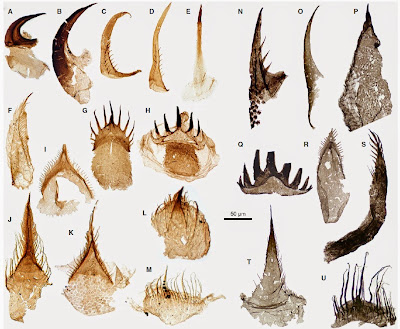Priapulid Worms are a form of marine worms with denticle-covered
pharynxes which can be everted to form proboscises. They are a minor element of
modern marine faunas, largely restricted to deep marine muds and other
environments where oxygen levels are low and they face less competition from
other forms of Worms. However in the Cambrian Period they appear to have been a
major component of marine faunas in many areas. The palaeontologist Charles
Doolittle Walcott described the Priapulid Worm genus Ottoia from the Middle Cambrian Burgess Shale in 1911, originally
designating three species, Ottoia prolifica,
Ottoia minor and Ottoia tenuis, however Ottoia minor has
since been moved to a separate genus, Ancalagon,
and Ottoiatenuis has been recognized
as a (quite unrelated) Enteropneust, leaving only a single species in the
genus. A variety of Priapulid fossils from other Cambrian deposits have also
been assigned to the genus, though most of these are somewhat dubious.
In a paper published in the journal Palaeontology on 6 May 2015, Martin Smith of the Department of Earth Sciences at the University of Cambridge, Thomas Harvey of the Department of Geology at the University of Leicester and Nicholas Butterfield, also of the Department of Earth Sciences at the University of
Cambridge re-examine the genus Ottoia,
concluding that there are in fact two species present in the Burgess Shale, and
examine the status of Priapulid denticles from other Cambrian localities.
Smith et al. paid
particular attention to the denticles of Ottoia,
noting that it has several regions on its pharynx, each with denticles with a
different morphology. While these were consistent across all the Burgess Shale
fossils, one horizon within the deposits contained (exclusively) specimens with
a distinctive morphology present in one of these bands, which they refer to as
the Type B teeth.
The new species is named Ottoia tricuspida,
in reference to its Type B teeth, which have three cusps. In the other
described species the Type B teeth have a large central cusp surrounded by four
to eight smaller ones, decreasing in size away from the centre. In addition the
new species has a double row of Type A teeth, whereas Ottoia prolifica has only a single row.
Ottoia tricuspida. (A) Complete specimen. (B) Enlargement of proboscis. Scale bars
represent 10 mm (A); 2 mm (B). Smith et
al. (2015).
All of the known specimens of Ottoia tricuspida come
from a single horizon within the Burgess Shale, 120–130 cm below the base of
the Phyllopod Bed, with a single possible occurrence in the Upper Walcott
Quarry. Smith et al. consider the
possibilities that it may represent members of the species Ottoia prolifica of a different sex or developmental stage as all the
specimens on this horizon appear to belong to Ottoia tricuspida with no specimens of Ottoia prolifica present, whereas on other horizons the reverse is
true, and because a wide range of specimen sizes are found in both
morphologies.
Schematic diagrams of Ottoia sclerite morphologies. Smith et al. (2015).
Specimens assigned to Ottoiahave
also been reported from the Pioche Shale in Nevada, the Marjum Formation and
Spence Shale of Utah, the Conasauga Formation of Georgia, the Chancellor Basin
of Canada and the Kaili Formation of China. However none of these fossils has
been fully described, and most are somewhat dubious, making confident
assignment to the genus impossible until such time as these fossils can be
properly examined and assessed.
However disarticulated Priapulid denticles are a common feature of
Cambrian deposits, and the potential exists to detect Ottoia from such denticles. Smith et al. examined denticles from the Pika Formation of westernmost
Jasper National Park, Alberta, the Deadwood Formation of Saskatchewan, and in
both cases determined that Ottoia prolifica was
present.
Small Carbonaceous Fossils
from the Deadwood and Pika formations assigned to Ottoia prolifica. (A–M) Teeth from a single sample of the Deadwood
Formation (Riley Lake drillcore at 1300 m), interpreted as tail hooks (A–B),
introvert hooks (C–D), a coronal spine (E), a Type A tooth (F), a Type B tooth
(G), a Type B tooth with surrounding cuticle (H), morphologies intermediate
between tooth types B, C and D (I–L), and a Type D tooth (M). (N–U)Teeth from
the Pika Formation, interpreted as an introvert hook (N), an introvert hook
without submarginal denticles (O), a Type A-like tooth (P), a Type B tooth (Q),
a tooth possibly intermediate between Type B and Type C (R), a Type C tooth
(S), an intermediate between Type C and Type D morphologies (T), and a Type D
tooth (U). Scale bar represents 50 μm. Smith et
al. (2015).
See also…
Vetulicolians are an enigmatic group of Cambrian fossils known from the
Chengjiang and Guanshan biotas of South China, Sirius Passet in
Greenland and the Burgess Shale in western Canada. They have...
In 1997 Stefan Bengtson of the Department of Palaeozoology at the Swedish Museum of Natural History and Yue Zhao of the Institute of Geology of the Chinese Academy of Geological Sciences announced the discovery of fossilized animal embryos from basal...
The Lophotrochozoa are a diverse group of Invertebrate animals indicated
to have a common ancestry by genetic analysis. The group includes the
Annelida, Mollusca, Bryozoa, Cycliophora, Brachiopoda, Entoprocta and
Phoronida. Within this group several groups are united by the presence
of a crown of tentacles (the Lophophore) surrounding the mouth, which
continuously opens and shuts while...
Follow Sciency Thoughts on Facebook.






